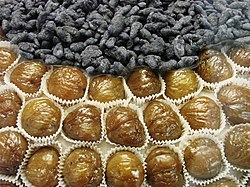Marron Glacê
 |
|
| Type | Confectionery |
|---|---|
| Place of origin | Northern Italy/Southern France |
| Region or state | Piedmont/Rhône-Alpes |
| Main ingredients | Chestnuts, sugar |
| |
|
A marron glacé (plural marrons glacés) is a confection, originating in southern France and northern Italy consisting of a chestnut candied in sugar syrup and glazed. Marrons glacés are an ingredient in many desserts and are also eaten on their own.
Candied chestnuts appeared in chestnut-growing areas in northern Italy and southern France shortly after the crusaders returned to Europe with sugar. Cooking with sugar allowed creation of new confectioneries. A candied chestnut confection was probably served around the beginning of the 15th century in Piedmont, among other places. But marrons glacés as such (with the last touch of 'glazing'), may have been created only in the 16th century.Lyon and Cuneo dispute the title for the addition of the glazing, or icing, that makes the real marron glacé.
The earliest known records of a recipe for marron glacés were written during the XVI century by an Italian cook that worked for Charles Emmanuel I, Duke of Savoy [1580], and by the French at the end of 17th century in Louis XIV's Versailles court. In 1667, François Pierre La Varenne, ten years' chef de cuisine to Nicolas Chalon du Blé, Marquis of Uxelles (near Lyon and a chestnut-producing area), and foremost figure of the nouvelle cuisine movement of the time, published his best-selling book Le parfaict confiturier. In it he describes "la façon de faire marron pour tirer au sec" ("the way to make (a) chestnut (so as) to 'pull it dry'"); this may well be the first record of the recipe for marrons glacés. "Tirer au sec" means, in a confectionery context, "to remove (what's being candied) from the syrup". La Varenne's book was edited thirty times over seventy-five years.
...
Wikipedia
